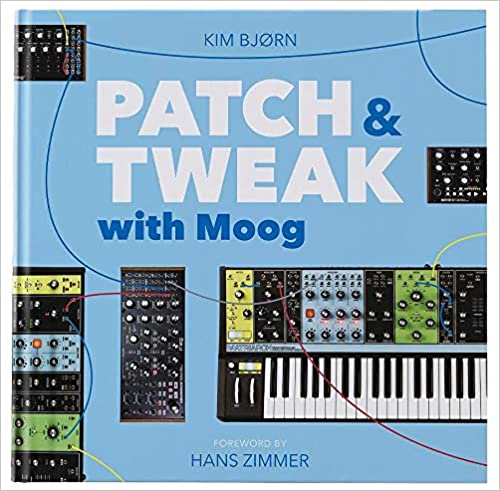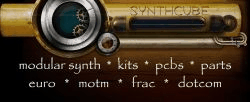
Showing posts sorted by relevance for query Audulus 2 Minute Tip. Sort by date Show all posts
Showing posts sorted by relevance for query Audulus 2 Minute Tip. Sort by date Show all posts
Saturday, January 16, 2016
Audulus 2 Minute Tips
Published on Jan 16, 2016 Bimini Road
iTunes: Audulus 3 - Audulus LLC
"Don't know how to make sound in Audulus? It's pretty easy! Just follow along with these 2 minute tips.
The 2 Minute Tip series breaks apart topics on Audulus into bite-sized chunks. I don't talk during the tutorials (though there are a few notes that pop up), and this is so that international viewers who don't understand English well don't feel left out. Familiarize yourself with the node menu and my navigation won't be so mystifying. In the future, we'll develop a finger press indicator so you can see where I'm tapping.
www.audulus.com
forum.audulus.com
www.biminiroadelectronics.com/audulus"
Playlist:
Audulus 2 Minute Tip - 1: How to Get Sound
Audulus 2 Minute Tip - 2: How to Make a Tremolo Effect
Audulus 2 Minute Tip - 3: How to Make a Vibrato Effect
Audulus 2 Minute Tip - 4 - How to Make a Sub Synth with Modules
Audulus 2 Minute Tip - 5 - How to Make a Module
Audulus 2 Minute Tip - 6: How to Make an Auto Wah Effect
Audulus 2 Minute Tip - 8: How to Make a Muxing Sequencer
Audulus 2 Minute Tip - 9: The Best AB Switch
Audulus 2 Minute Tip - 10: How to Make an Autopanner Effect
Audulus 2 Minute Tip - 11: How to Use the Mapper Node
Audulus 2 Minute Tip - 12: How to Turn a Timer into a Saw LFO
Audulus 2 Minute Tip - 13: How make LFOs with the Phasor Node
Audulus 2 Minute Tip - 14: How to Use the Spline Node
Audulus 2 Minute Tip - 15: Introduction to Flipflop Memory
Monday, January 18, 2016
Audulus 2 Minute Tip - 3: How to Make a Vibrato Effect
Published on Jan 18, 2016 Bimini Road
iTunes: Audulus 3 - Audulus LLC
"Vibrato is sometimes confused with tremolo thanks to Fender amps, which incorrectly label their tremolo circuits as vibrato. Vibrato and tremolo are easy to parse however: tremolo is volume (amplitude) modulation, while vibrato is pitch (frequency) modulation. When you wiggle your finger back and forth on a string on a violin, *that's* vibrato - what you are doing is shortening and lengthening the amount of vibrating string between your finger and the tailpiece (or saddle on a guitar).
Making a pitch-shifting vibrato effect that induces frequency changes in audio is a little more complex, so this just focuses on how to add vibrato to an oscillator, which is very easy.
Wondering how to begin designing effects in Audulus? You can't get more simple than a Tremolo.
A Tremolo effect (known to Fender enthusiasts as "Vibrato" but we'll get to that one later) is a modulated amplitude (i.e. volume) level. Electrically, this is usually done by driving a lamp or LED with an LFO circuit, while the audio path runs through a light-dependent resistor (LDR). The Light + LDR makes an Optocoupler. This isolates the LFO from the circuit and keeps your audio path super clean.
In Audulus, however, none of that is necessary. All you need to make a Tremolo is an LFO and a Level node. Apply the LFO's output to the Level node, run your audio in and out, and bam, you have a Tremolo!
This tutorial also shows you some beginning steps you can take to modify the LFO: adding to the signal increases the "floor," or how low the volume gets. Multiplying the signal (really, dividing, since we're multiplying by a number between 0-1), will expand or shrink its overall range.
The 2 Minute Tip series breaks apart topics on Audulus into bite-sized chunks. I don't talk during the tutorials (though there are a few notes that pop up), and this is so that international viewers who don't understand English well don't feel left out. Familiarize yourself with the node menu and my navigation won't be so mystifying. In the future, we'll develop a finger press indicator so you can see where I'm tapping.
http://www.audulus.com
http://forum.audulus.com
http://www.biminiroadelectronics.com/...
https://soundcloud.com/biminiroadmusi..."
More 2 Minute Tip tutorials here.
Wednesday, January 20, 2016
Audulus 2 Minute Tip - 5 - How to Make a Module
Published on Jan 20, 2016 Bimini Road
You'll find all parts in the series here.
Audulus for iOS | Audulus for Mac
"This 2 minute Tip shows you how to make a simple attenuator module in Audulus - use the principles you see here to make your own modules of any kind!
The 2 Minute Tip series breaks apart topics on Audulus into bite-sized chunks. I don't talk during the tutorials (though there are a few notes that pop up), and this is so that international viewers who don't understand English well don't feel left out. Familiarize yourself with the node menu and my navigation won't be so mystifying. In the future, we'll develop a finger press indicator so you can see where I'm tapping.
http://www.audulus.com
http://forum.audulus.com
http://www.biminiroadelectronics.com/...
https://soundcloud.com/biminiroadmusi..."
Tuesday, January 19, 2016
Audulus 2 Minute Tip - 4 - How to Make a Sub Synth with Modules
Published on Jan 19, 2016 Bimini Road
Audulus for iOS | Audulus for Mac
"This tutorial shows you how to set up a subtractive synthesizer in Audulus using the module library while navigating with the tag system. Subtractive synthesis begins with a harmonic-rich waveform (Square, Saw, or Triangle) and subtracts harmonics using a filter.
There are many ways to make a subtractive synth - adding more oscillators and detuning them slightly will give you a fatter sound. You can use Sine waves, but they don't respond as well to this method. Sine waves are best used in subtractive synthesis to bolster the low end, usually known as a sub oscillator. This sub oscillator will deepen the sound and make it more robust. However, for this tutorial, I just wanted to keep it as simple as possible. Towards the end, I added some LFOs to control the values of the steps of the step sequencer to make for a more interesting, semi-random sequence.
The 2 Minute Tip series breaks apart topics on Audulus into bite-sized chunks. I don't talk during the tutorials (though there are a few notes that pop up), and this is so that international viewers who don't understand English well don't feel left out. Familiarize yourself with the node menu and my navigation won't be so mystifying. In the future, we'll develop a finger press indicator so you can see where I'm tapping.
http://www.audulus.com
http://forum.audulus.com
http://www.biminiroadelectronics.com/...
https://soundcloud.com/biminiroadmusi..."
Saturday, January 30, 2016
Audulus 2 Minute Tip - 15: Introduction to Flipflop Memory
Published on Jan 30, 2016 Bimini Road
Get Audulus for: iOS | Mac | Windows/Linux
"This video is a primer on Flipflop Memory - flipflops are the smallest unit of memory possible - it's either a one or a zero. Each time a flipflop is pinged by the Midi button, it reverses its state (it flipflops!).
With this setup, you can change 8 different parameters on or off with just one button and one knob.
The fundamentals laid out here are necessary for understanding how to make the *very* complex sequencers and pseudo-computers that are possible within Audulus.
The 2 Minute Tip series breaks apart topics on Audulus into bite-sized chunks. I don't talk during the tutorials (though there are a few notes that pop up), and this is so that international viewers who don't understand English well don't feel left out. Familiarize yourself with the node menu and my navigation won't be so mystifying. In the future, we'll develop a finger press indicator so you can see where I'm tapping.
http://www.audulus.com
http://forum.audulus.com
http://www.biminiroadelectronics.com/...
https://soundcloud.com/biminiroadmusi..."
All parts here.
Sunday, January 17, 2016
Audulus 2 Minute Tip - How to Make a Tremolo Effect
Published on Jan 17, 2016 Bimini Road
"Wondering how to begin designing effects in Audulus? You can't get more simple than a Tremolo.
A Tremolo effect (known to Fender enthusiasts as "Vibrato" but we'll get to that one later) is a modulated amplitude (i.e. volume) level. Electrically, this is usually done by driving a lamp or LED with an LFO circuit, while the audio path runs through a light-dependent resistor (LDR). The Light + LDR makes an Optocoupler. This isolates the LFO from the circuit and keeps your audio path super clean.
In Audulus, however, none of that is necessary. All you need to make a Tremolo is an LFO and a Level node. Apply the LFO's output to the Level node, run your audio in and out, and bam, you have a Tremolo!
This tutorial also shows you some beginning steps you can take to modify the LFO: adding to the signal increases the "floor," or how low the volume gets. Multiplying the signal (really, dividing, since we're multiplying by a number between 0-1), will expand or shrink its overall range.
The 2 Minute Tip series breaks apart topics on Audulus into bite-sized chunks. I don't talk during the tutorials (though there are a few notes that pop up), and this is so that international viewers who don't understand English well don't feel left out. Familiarize yourself with the node menu and my navigation won't be so mystifying. In the future, we'll develop a finger press indicator so you can see where I'm tapping.
http://www.audulus.com
http://forum.audulus.com
http://www.biminiroadelectronics.com/...
https://soundcloud.com/biminiroadmusi..."
More here.
Wednesday, January 27, 2016
Audulus 2 Minute Tip - 12: How to Turn a Timer into a Saw LFO
Published on Jan 27, 2016 Bimini Road
Get Audulus for: iOS | Mac | Windows/Linux
"This is a simple way to turn a timer into a Saw LFO for those who want to shave away every bit of CPU time they can (the Phasor LFO uses fractionally more CPU time). Unlike the Phasor LFO, however, you can see that it doesn't act predictably when you change the speed, and the speed control is not independent from the amplitude.
For more reading about the modulo operation, check out this enlightening Wikipedia article: https://en.wikipedia.org/wiki/Modulo_...
The 2 Minute Tip series breaks apart topics on Audulus into bite-sized chunks. I don't talk during the tutorials (though there are a few notes that pop up), and this is so that international viewers who don't understand English well don't feel left out. Familiarize yourself with the node menu and my navigation won't be so mystifying. In the future, we'll develop a finger press indicator so you can see where I'm tapping.
http://www.audulus.com
http://forum.audulus.com
http://www.biminiroadelectronics.com/...
https://soundcloud.com/biminiroadmusi..."
All parts here.
Tuesday, January 26, 2016
Audulus 2 Minute Tip - 11: How to Use the Mapper Node
Published on Jan 26, 2016 Bimini Road
Get Audulus for: iOS | Mac | Windows/Linux
"This is a quick walkthrough of how to use the Mapper node. The mapper is the quickest way to get a logarithmic or exponential response from a knob, but it's so much more than that! Note: you cannot move the midpoint of the mapper node left or right (yet).
The 2 Minute Tip series breaks apart topics on Audulus into bite-sized chunks. I don't talk during the tutorials (though there are a few notes that pop up), and this is so that international viewers who don't understand English well don't feel left out. Familiarize yourself with the node menu and my navigation won't be so mystifying. In the future, we'll develop a finger press indicator so you can see where I'm tapping.
http://www.audulus.com
http://forum.audulus.com
http://www.biminiroadelectronics.com/...
https://soundcloud.com/biminiroadmusi..."
All parts here.
Sunday, January 24, 2016
Audulus 2 Minute Tip - 9: The Best AB Switch
Published on Jan 24, 2016 Bimini Road
Get Audulus for: iOS | Mac | Windows/Linux
"I used to make AB switches with Crossfader nodes, but this is a far more elegant solution - works in both directions with lights with no logic expressions! Simplicity is the ultimate sophistication.
The *-1+1 is a common function inverter - you'll see it pop up anywhere you want one control to do two opposite functions.
The 2 Minute Tip series breaks apart topics on Audulus into bite-sized chunks. I don't talk during the tutorials (though there are a few notes that pop up), and this is so that international viewers who don't understand English well don't feel left out. Familiarize yourself with the node menu and my navigation won't be so mystifying. In the future, we'll develop a finger press indicator so you can see where I'm tapping.
http://www.audulus.com
http://forum.audulus.com
http://www.biminiroadelectronics.com/...
https://soundcloud.com/biminiroadmusi..."
All parts here.
Friday, January 29, 2016
Audulus 2 Minute Tip - 14: How to Use the Spline Node
Published on Jan 29, 2016 Bimini Road
Get Audulus for: iOS | Mac | Windows/Linux
"This is a simple demonstration of the basic functions of the Spline node. One of my favorite things to do with a Spline is to take its output, multiply it a little, and then run that output into a Quantizer module and then into a synthesizer (thanks user JDRaoul for coming up with this technique). It allows for quick, on-the-fly melody generation that really natural.
Double click to add or delete points on the spline.
Why is it called a spline? This is why: https://en.wikipedia.org/wiki/Spline_...
The 2 Minute Tip series breaks apart topics on Audulus into bite-sized chunks. I don't talk during the tutorials (though there are a few notes that pop up), and this is so that international viewers who don't understand English well don't feel left out. Familiarize yourself with the node menu and my navigation won't be so mystifying. In the future, we'll develop a finger press indicator so you can see where I'm tapping.
http://www.audulus.com
http://forum.audulus.com
http://www.biminiroadelectronics.com/...
https://soundcloud.com/biminiroadmusi..."
All parts here.
Saturday, January 23, 2016
Audulus 2 Minute Tip - 8: How to Make a Muxing Sequencer
Published on Jan 23, 2016 Bimini Road
Audulus for iOS | Audulus for Mac
"You don't just need a Sequencer node to make a sequencer. I actually prefer to make them this way - it's very easy to apply an LFO and change the directionality.
To use this sequencer to control an oscillator (instead of, say, a parameter of an effect), just send it through a Quantizer module.
...And why do I multiply it by 7.99 and not 8? Well, x8 wraps around back to 1, since the value range of 0-.999... is the first step, and 7-7.999... is the value range of the last step. If you set the max to just 7, it would only reach the final step for the duration of 1 sample.
The 2 Minute Tip series breaks apart topics on Audulus into bite-sized chunks. I don't talk during the tutorials (though there are a few notes that pop up), and this is so that international viewers who don't understand English well don't feel left out. Familiarize yourself with the node menu and my navigation won't be so mystifying. In the future, we'll develop a finger press indicator so you can see where I'm tapping.
http://www.audulus.com"
All parts here.
Friday, January 22, 2016
Audulus 2 Minute Tip - 7: How to Make a Random Sample & Hold
Published on Jan 22, 2016 Bimini Road
Audulus for iOS | Audulus for Mac
"Yearning to harness chaos? A Random node through a Sample and Hold node is just what you're looking for! Each pulse from the LFO is like a snapshot in time - use the output to modify other effects (really wonderful on filters).
The 2 Minute Tip series breaks apart topics on Audulus into bite-sized chunks. I don't talk during the tutorials (though there are a few notes that pop up), and this is so that international viewers who don't understand English well don't feel left out. Familiarize yourself with the node menu and my navigation won't be so mystifying. In the future, we'll develop a finger press indicator so you can see where I'm tapping.
http://www.audulus.com"
Thursday, January 21, 2016
Audulus 2 Minute Tip - 6: How to Make an Auto Wah Effect
Published on Jan 21, 2016 Bimini Road
Audulus for iOS | Audulus for Mac
All parts here.
"An Auto Wah is volume-controlled filter. The louder you signal is, the higher the frequency sweeps. In this demo, I just used the microphone on my iPad picking up a Jess Glynne song through my speakers. Auto Wahs generally sound best on one instrument - you hear them most often on guitars.
Auto Wahs are also knows as Envelope Controlled Filters (ECF, as opposed to VCF, a voltage controlled filter).
The 2 Minute Tip series breaks apart topics on Audulus into bite-sized chunks. I don't talk during the tutorials (though there are a few notes that pop up), and this is so that international viewers who don't understand English well don't feel left out. Familiarize yourself with the node menu and my navigation won't be so mystifying. In the future, we'll develop a finger press indicator so you can see where I'm tapping.
http://www.audulus.com"
Monday, January 25, 2016
Audulus 2 Minute Tip - 10: How to Make an Autopanner Effect
Published on Jan 25, 2016 Bimini Road
Get Audulus for: iOS | Mac | Windows/Linux
"An autopanner is like an invisible hand turning the pan pot. Whether you like 'em fast or slow, this is the easiest, lowest-resource way to do it. The 1 value represents your sound source, and the two meters are the Left and Right stereo channels. Apply whatever type of LFO or other control signal you'd like (you can even use feedback!).
The 2 Minute Tip series breaks apart topics on Audulus into bite-sized chunks. I don't talk during the tutorials (though there are a few notes that pop up), and this is so that international viewers who don't understand English well don't feel left out. Familiarize yourself with the node menu and my navigation won't be so mystifying. In the future, we'll develop a finger press indicator so you can see where I'm tapping.
http://www.audulus.com
http://forum.audulus.com
http://www.biminiroadelectronics.com/...
https://soundcloud.com/biminiroadmusi..."
All parts here.
Thursday, January 28, 2016
Audulus 2 Minute Tip - 13: How make LFOs with the Phasor Node
Published on Jan 28, 2016 Bimini Road
Get Audulus for: iOS | Mac | Windows/Linux
"This video shows you how to harness the Phasor node and turn it into several different waveshapes. The Phasor runs from 0 to 2pi - without any math, it makes a Saw LFO that goes from 0 to about 6 - these equations tame it, however, and turn it into other shapes. I did not come up with these formulas myself - some came from Taylor and others from the forum.
These equations create DS LFOs between 0 and 1 (DS = direct signal, like DC or direct current). In general DS LFOs are more useful for manipulating knobs - if you keep all your knobs and modulation inputs accepting a range of 0-1 and then translate with math on the inside of the module when necessary, everything talks to everything else much more easily.
As for why the Phasor runs from 0 to 2pi (instead of just pi), refer to this enlightening Wikipedia article: https://en.wikipedia.org/wiki/Unit_ci...
The 2 Minute Tip series breaks apart topics on Audulus into bite-sized chunks. I don't talk during the tutorials (though there are a few notes that pop up), and this is so that international viewers who don't understand English well don't feel left out. Familiarize yourself with the node menu and my navigation won't be so mystifying. In the future, we'll develop a finger press indicator so you can see where I'm tapping.
http://www.audulus.com
http://forum.audulus.com
http://www.biminiroadelectronics.com/...
https://soundcloud.com/biminiroadmusi..."
All parts here.
Thursday, January 21, 2016
Teenage Engineering Introduces New Pocket Operators - Arcade, Office, and Robot
Audulus 2 Minute Tip - 6: How to Make an Auto Wah Effect
Published on Jan 21, 2016 teenageengineering
"introducing PO-20 office by teenage engineering and cheap monday."
Update: CUCKOO tutorial added below!
Published on Jan 21, 2016 teenageengineering
"introducing PO-20 office by teenage engineering and cheap monday."
Update: CUCKOO tutorial added below!
LABELS/MORE:
NAMM,
NAMM2016,
New,
New Synths,
New Synths in 2016,
Teenage Engineering,
Updates,
Video
HOME













© Matrixsynth - All posts are presented here for informative, historical and educative purposes as applicable within fair use.
MATRIXSYNTH is supported by affiliate links that use cookies to track clickthroughs and sales. See the privacy policy for details.
MATRIXSYNTH - EVERYTHING SYNTH













© Matrixsynth - All posts are presented here for informative, historical and educative purposes as applicable within fair use.
MATRIXSYNTH is supported by affiliate links that use cookies to track clickthroughs and sales. See the privacy policy for details.
MATRIXSYNTH - EVERYTHING SYNTH




























